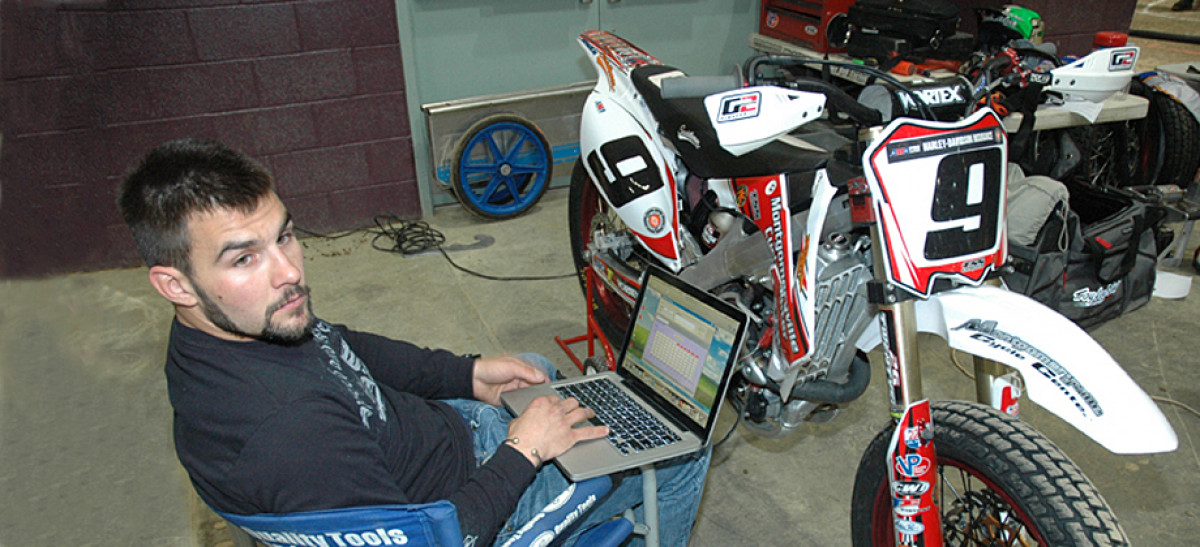
Notes from the Blue Groove, #1
Notes from the Blue Groove, #1 - A new column by Mark Gardiner
Car-pooling, for a 2,000-mile commute
 With oil hovering over $107 a barrel and gas already above $4 in several states (and it's not even the summer travel season yet), everyone's feeling pinched at the pump. But if you're an AMA Pro Flat Track racer, high fuel prices aren't just an inconvenience; they can throw a wrench into your business plan.
With oil hovering over $107 a barrel and gas already above $4 in several states (and it's not even the summer travel season yet), everyone's feeling pinched at the pump. But if you're an AMA Pro Flat Track racer, high fuel prices aren't just an inconvenience; they can throw a wrench into your business plan.
Guys like Bryan Smith (left), Kenny Coolbeth, and Jared Mees are stars at a Grand National flat track race, but after the checkered flag flies they're independent entrepreneurs, trying to turn a profit in one of the toughest small businesses going. Win or lose, at the end of the night they load their own trailers and drive to the next race—or, if there's a break, home to regroup and work on their bikes, always on the lookout for an outlaw race along the way where they can pick up an extra few hundred bucks. The reality of making a living this way is that for every minute you spend racing, there's an hour spent driving between races. A fifty-cent swing in fuel prices can take thousands of dollars off a racer's bottom line.
Last weekend, the Grand National Championship hit its second venue of the year, in DuQuoin, Illinois, and this weekend there's a TT and a short track on tap in Salinas, California—over 2,000 miles away. Since most pro flat trackers live in the heart of the country, it's a 4,000-plus mile commute. So, like a lot of commuters faced with high fuel prices, they're car-pooling.
 Coolbeth, Smith, and national #26, Brandan Bergen, are sharing the drive to California with Jared Mees (right). After DuQuoin, the four went back to Bergan's sponsor (Reiman's Harley-Davidson out of Kewanee, Illinois) and used his workshop to prepare their bikes for Salinas. Then they piled into the deluxe motor home that Mees' sponsor, Craig Rogers of Rogers-Lake Racing, lets him use to drive to events. The Freightliner/Showhauler has a 12-foot garage area in the back, which is packed to the rafters with nine bikes, gear, and spares. Up front, it's basically a rolling yacht. If ya' gotta' drive non-stop for a couple of days, then race, then drive non-stop home again, it's the way to go, and splitting the diesel bill four ways saves everybody money.
Coolbeth, Smith, and national #26, Brandan Bergen, are sharing the drive to California with Jared Mees (right). After DuQuoin, the four went back to Bergan's sponsor (Reiman's Harley-Davidson out of Kewanee, Illinois) and used his workshop to prepare their bikes for Salinas. Then they piled into the deluxe motor home that Mees' sponsor, Craig Rogers of Rogers-Lake Racing, lets him use to drive to events. The Freightliner/Showhauler has a 12-foot garage area in the back, which is packed to the rafters with nine bikes, gear, and spares. Up front, it's basically a rolling yacht. If ya' gotta' drive non-stop for a couple of days, then race, then drive non-stop home again, it's the way to go, and splitting the diesel bill four ways saves everybody money.
"We don't have big teams that will get our bikes there, and [let us] just fly to races," says Smith. "Obviously, it's good to split the driving, but the big thing is cutting the fuel costs."
I asked Bryan how much he spent last year on gas, and he told me, "I should know that, because I just did my taxes! You can deduct either gas or mileage, and it works out better for me to deduct the mileage. Last year I drove over 30,000 miles in my van, and I went to a few races with other people. I figured it out and this year, if I drove to all the races myself, I'd be pushing 40,000 miles."
They plan to keep two guys up front the entire way, so the driver always has someone to talk to, but there's room for the others to sleep, so it wouldn't be a problem to drive virtually non-stop. Smith told me that the day before they left, Mees cooked them a pretty good breakfast, so he'll be the one pulling chef duty in the onboard kitchen.
That much testosterone in one vehicle could spell trouble. "If it was the end of the season, we might come back through Las Vegas and raise a little hell, but this early in the year, we'll be keeping it pretty clean," Smith promised. Then he added, "We're really good friends, and we'll have fun—there could be some fireworks flying out the windows along the way."
Latest news































